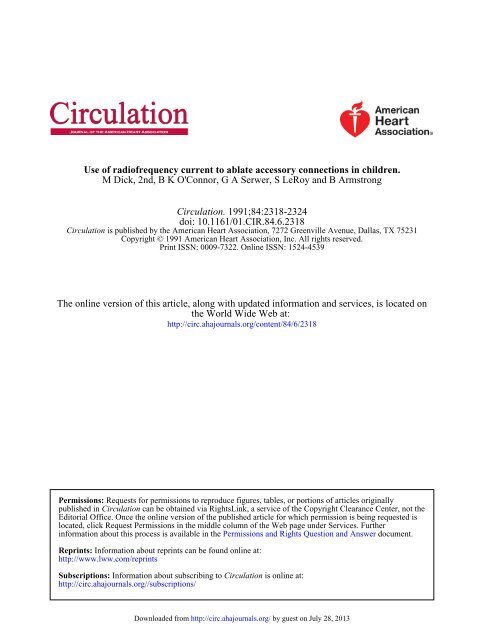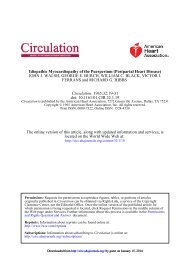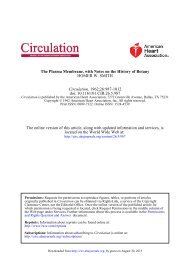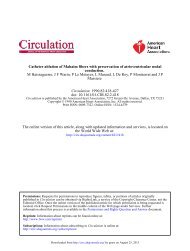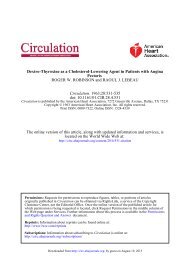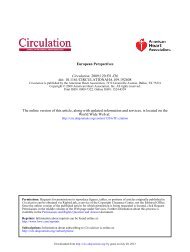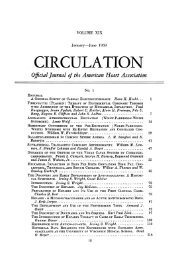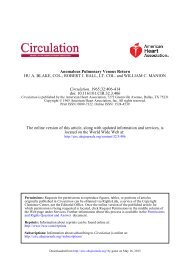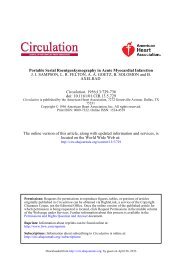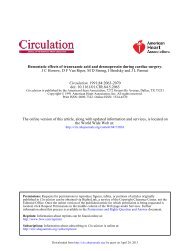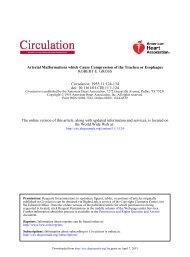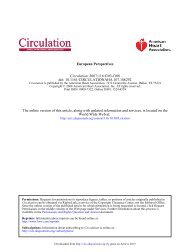Use of Radiofrequency Current to Ablate Accessory ... - Circulation
Use of Radiofrequency Current to Ablate Accessory ... - Circulation
Use of Radiofrequency Current to Ablate Accessory ... - Circulation
You also want an ePaper? Increase the reach of your titles
YUMPU automatically turns print PDFs into web optimized ePapers that Google loves.
<strong>Use</strong> <strong>of</strong> radi<strong>of</strong>requency current <strong>to</strong> ablate accessory connections in children.<br />
M Dick, 2nd, B K O'Connor, G A Serwer, S LeRoy and B Armstrong<br />
<strong>Circulation</strong>. 1991;84:2318-2324<br />
doi: 10.1161/01.CIR.84.6.2318<br />
<strong>Circulation</strong> is published by the American Heart Association, 7272 Greenville Avenue, Dallas, TX 75231<br />
Copyright © 1991 American Heart Association, Inc. All rights reserved.<br />
Print ISSN: 0009-7322. Online ISSN: 1524-4539<br />
The online version <strong>of</strong> this article, along with updated information and services, is located on<br />
the World Wide Web at:<br />
http://circ.ahajournals.org/content/84/6/2318<br />
Requests for permissions <strong>to</strong> reproduce figures, tables, or portions <strong>of</strong> articles originally<br />
published in <strong>Circulation</strong> can be obtained via RightsLink, a service <strong>of</strong> the Copyright Clearance Center, not the<br />
Edi<strong>to</strong>rial Office. Once the online version <strong>of</strong> the published article for which permission is being requested is<br />
located, click Request Permissions in the middle column <strong>of</strong> the Web page under Services. Further<br />
information about this process is available in the Permissions and Rights Question and Answer document.<br />
Permissions:<br />
Reprints: Information about reprints can be found online at:<br />
http://www.lww.com/reprints<br />
Subscriptions: Information about subscribing <strong>to</strong> <strong>Circulation</strong> is online at:<br />
http://circ.ahajournals.org//subscriptions/<br />
Downloaded from<br />
http://circ.ahajournals.org/ by guest on July 28, 2013
2318<br />
<strong>Use</strong> <strong>of</strong> Radi<strong>of</strong>requency <strong>Current</strong> <strong>to</strong> <strong>Ablate</strong><br />
<strong>Accessory</strong> Connections in Children<br />
Macdonald Dick II, MD; Brian K. O'Connor, MD; Gerald A. Serwer, MD;<br />
Sarah LeRoy, RN, MS; and Brian Armstrong<br />
Background. Several investiga<strong>to</strong>rs have recently ablated electrophysiologically mapped accessory<br />
connections in the adult human myocardium by using radi<strong>of</strong>requency current. To examine<br />
the effectiveness and safety <strong>of</strong> radi<strong>of</strong>requency current for ablation <strong>of</strong> accessory connections in<br />
children, 20 consecutive patients (age, 3-18 years) with preexcitation and/or supraventricular<br />
tachycardia were evaluated by electrophysiological study.<br />
Methods and Results. Nineteen <strong>of</strong> the 20 patients were completely studied and demonstrated<br />
accessory connections. After identification <strong>of</strong> the earliest retrograde atrial activation site, a<br />
steerable 7F catheter (with a 4-mm-long electrode at the distal tip) was placed within the<br />
ventricular cavity ipsilateral <strong>to</strong> the accessory connection and positioned at the atrioventricular<br />
valve annulus directly opposite the earliest point <strong>of</strong> retrograde atrial activation. Radi<strong>of</strong>requency<br />
current was delivered at 50-65 volts for 10-60 seconds at a frequency <strong>of</strong> 500 kHz. Radi<strong>of</strong>requency<br />
pulses were delivered for two <strong>to</strong> 26 trials. Upon completion <strong>of</strong> radi<strong>of</strong>requency trials,<br />
repeat electrophysiological testing was performed. Thirteen <strong>of</strong> 19 subjects (68%) experienced<br />
definite successful ablation <strong>of</strong> their accessory pathway; an additional patient had probable<br />
successful ablation, yielding an overall success rate <strong>of</strong> 74%. Eighty-seven percent <strong>of</strong> individuals<br />
with a left-sided pathway had permanent ablation and 100% with a manifest left-sided pathway<br />
experienced successful ablation. Only 29% <strong>of</strong> the first seven patients had a successful result; in<br />
contrast, 92% <strong>of</strong> the next 12 patients had successful interruption <strong>of</strong> their accessory pathways.<br />
After ablation, 4-day continuous electrocardiographic telemetry disclosed no significant<br />
arrhythmias. CPK enzyme rises peaked at 12-24 hours. The rise was excessive and associated<br />
with general anesthesia in five patients. The isoenzyme MB fraction rose mildly in five other<br />
patients and returned <strong>to</strong> normal within 72 hours. No clinical or electrocardiographic evidence<br />
<strong>of</strong> myocardial ischemia was detected. Follow-up for 4-12 months indicates no return <strong>of</strong><br />
preexcitation or tachycardia in any patient whose accessory connection was successfully<br />
ablated.<br />
Conclusions. This experience indicates that radi<strong>of</strong>requency current is an effective and safe<br />
technique for ablation <strong>of</strong> accessory connections in children. (<strong>Circulation</strong> 1991;84:2318-2324)<br />
Supraventricular tachycardia (SVT) is the most<br />
common sustained cardiac arrhythmia in children;<br />
approximately 50-60% <strong>of</strong> SVT is supported<br />
by a reentrant circuit comprising the atria,<br />
atrioventricular node-His-Purkinje system, ventricular<br />
myocardium, and an accessory connection conducting<br />
in the retrograde direction.' When this tachycardia<br />
is frequent, sustained, and associated with<br />
significant symp<strong>to</strong>ms (palpitations, faintness, dizziness,<br />
presyncope, syncope, and, rarely, cardiac arrest;<br />
From the Division <strong>of</strong> Pediatric Cardiology (M.D.), C.S. Mott<br />
Children's Hospital and the Department <strong>of</strong> Pediatrics, University<br />
<strong>of</strong> Michigan, Ann Arbor.<br />
Address for reprints: Macdonald Dick II, MD, F1310, Box 0204,<br />
C. S. Mott Children's Hospital, 1500 East Medical Center Drive,<br />
Ann Arbor, MI 48109-0204.<br />
Received January 4, 1991; revision accepted July 23, 1991.<br />
3.7% in our population <strong>of</strong> children with preexcitation,<br />
four as the first symp<strong>to</strong>m, one <strong>of</strong> whom died),<br />
medical management is required. Chronic prophylaxis<br />
<strong>of</strong> this arrhythmia can <strong>of</strong>ten be achieved by<br />
pharmacological agents altering refrac<strong>to</strong>riness and/or<br />
conduction within one or more <strong>of</strong> the limbs <strong>of</strong> the<br />
reentrant circuit. Corrective therapy has, until recently,<br />
required surgical division <strong>of</strong> the accessory<br />
connection or direct current energy ablation <strong>of</strong> the<br />
accessory connection.2,3 Direct current creates a dispersive<br />
shock lesion in the targeted area <strong>of</strong> the<br />
myocardium and, in most instances, can be directed<br />
only <strong>to</strong>ward right posterior septal pathways. In 1987,<br />
Borggrefe and associates4 reported the use <strong>of</strong> radi<strong>of</strong>requency<br />
current <strong>to</strong> ablate accessory connections in<br />
humans. Since then, multiple preliminary reports in<br />
older patients5-12 and one in children13 have de-<br />
Downloaded from<br />
http://circ.ahajournals.org/ by guest on July 28, 2013
scribed the use <strong>of</strong> radi<strong>of</strong>requency current delivered<br />
through the catheter electrode tip juxtaposed <strong>to</strong> the<br />
accessory connection as an alternative mode <strong>of</strong> ablation.<br />
In this report, we outline our experience using<br />
radi<strong>of</strong>requency energy in 19 children <strong>to</strong> ablate accessory<br />
connections.<br />
Methods<br />
Twenty consecutive children (age, 3-18 years, median<br />
age, 12.5 years; 16 boys, four girls) with preexcitation<br />
and/or SVT submitted <strong>to</strong> diagnostic electrophysiological<br />
study were shown <strong>to</strong> have an accessory<br />
connection. One <strong>of</strong> the 20 subjects was excluded from<br />
the study because the coronary sinus could not be<br />
entered, leading <strong>to</strong> incomplete mapping <strong>of</strong> the accessory<br />
connection; his very fast conducting left posterior<br />
pathway was successfully divided at surgery.<br />
Thus, 19 patients compose the study group (Table 1).<br />
Eighteen <strong>of</strong> these 19 patients had documented recurrent<br />
symp<strong>to</strong>matic SVT; 13 were unresponsive <strong>to</strong> at<br />
least one antiarrhythmic medication. Two (No. 14<br />
and No. 19) had experienced documented ventricular<br />
fibrillation at initial presentation. Six had not received<br />
antiarrhythmic medication because symp<strong>to</strong>ms<br />
were either not frequent enough or not sufficiently<br />
severe as judged by the patients and parents. One<br />
15-year-old girl (No. 11), initially studied at another<br />
institution, had preexcitation with a rapid ventricular<br />
response <strong>to</strong> induced atrial fibrillation (shortest preexcited<br />
RR interval during atrial fibrillation was 240<br />
msec, decreasing <strong>to</strong> 220 msec with isoproterenol<br />
infusion) but had no spontaneous or inducible SVT.<br />
Informed consent was obtained from the parents and<br />
the patient (if age appropriate).<br />
The first seven patients were sedated with intramuscular<br />
midazolam (0.1 mg/kg) supplemented by<br />
intravenous midazolam (0.1 mg/kg) and morphine<br />
sulfate (0.1 mg/kg) as needed during the procedure.<br />
Based on the experience <strong>of</strong> the first seven, the next 13<br />
children were administered general anesthesia because<br />
<strong>of</strong> the anticipated prolonged time <strong>of</strong> the procedure.<br />
Standard programmed (Bloom Associates,<br />
Ltd., DTU 110) extrastimulation and electrophysiological<br />
recordings (Siemans Mingo 7, paper speed,<br />
100-200 mm/sec) were performed as previously described.3<br />
Precise mapping <strong>of</strong> retrograde atrial activation<br />
during SVT or ventricular pacing was carried out<br />
using a 7F orthogonal electrode catheter (Mansfield/<br />
Webster, No. 5211) placed through the left subclavian<br />
vein in<strong>to</strong> the coronary sinus in 18 <strong>of</strong> the 19<br />
patients. The coronary sinus was mapped in patient<br />
13, a 3-year-old boy, using a 5F quadripolar (interelectrode<br />
distance, 10 mm). A 7F steerable 5-mmspaced<br />
quadripolar catheter (Mansfield/Webster,<br />
No. 5250) was placed through the right femoral vein<br />
in<strong>to</strong> the right atrium <strong>to</strong> map the right atrioventricular<br />
groove, if necessary; the catheter positions were<br />
finely adjusted <strong>to</strong> find the earliest site <strong>of</strong> retrograde<br />
atrial activation during SVT or ventricular pacing.<br />
The recordings were scrutinized for possible Kent<br />
fiber potentials; however, no deliberate attempt was<br />
Dick et al RF Ablation <strong>of</strong> <strong>Accessory</strong> Connections in Children 2319<br />
made <strong>to</strong> record Kent fiber activation and no pro<strong>to</strong>cols<br />
were performed <strong>to</strong> verify them if they were<br />
thought <strong>to</strong> be present.<br />
After identification <strong>of</strong> the earliest activation site,<br />
the ventricular aspect <strong>of</strong> the atrioventricular grooves<br />
was mapped by placing the above-noted steerable 7F<br />
catheter (with a 4-mm-long electrode at the distal<br />
tip) within the ventricular cavity ipsilateral <strong>to</strong> the<br />
accessory connection and positioning it at the atrioventricular<br />
valve annulus directly opposite the earliest<br />
point <strong>of</strong> atrial activation (Figure 1) and/or Kent<br />
fiber potential (if recorded). The position was confirmed<br />
by recording through the ablating electrode<br />
catheter atrial (and ventricular) electrograms with<br />
the shortest obtainable AV interval antegrade and<br />
the shortest obtainable VA interval retrograde equal<br />
<strong>to</strong> or shorter than the shortest interval recorded<br />
through the mapping catheter. Because posteroseptal<br />
pathways may demonstrate variable antegrade<br />
and retrograde activation patterns,14 we mapped the<br />
septal region at the coronary sinus os and the tricuspid<br />
annulus adjacent <strong>to</strong> the atrioventricular node.<br />
Also, because the anterior septal pathway may lie<br />
very adjacent <strong>to</strong> the His bundle, although separated<br />
by the central fibrous body, mapping <strong>of</strong> suspected<br />
pathways in this region were performed with the<br />
ablating catheter in a 180-degree curve positioned in<br />
the right ventricular cavity under the tricuspid leaflet<br />
through both the inferior and superior vena cava<br />
approach. One thousand units/kg <strong>of</strong> heparin was<br />
administered intravenously (up <strong>to</strong> 3,000 units) and<br />
repeated every 90-120 minutes.<br />
Radi<strong>of</strong>requency current (Radionics, RFG-3C lesion<br />
genera<strong>to</strong>r system) was delivered at 50-70 volts<br />
for 10-60 seconds at a frequency <strong>of</strong> 500 kHz. Radi<strong>of</strong>requency<br />
pulses were delivered for two <strong>to</strong> 28 trials.<br />
If an increase in impedance was noted during current<br />
delivery, power was immediately discontinued and<br />
the ablating electrode catheter was removed and<br />
cleaned or replaced. To minimize energy delivered,<br />
initial pulses were delivered for 10-15 seconds because,<br />
from experience, if the ablating electrode is at<br />
the accessory connection, successful ablation occurs<br />
promptly upon reaching 50-60 volts (Figure 2).<br />
Termination <strong>of</strong> the trials was indicated by successful<br />
ablation (persistent loss <strong>of</strong> preexcitation or <strong>of</strong> retrograde<br />
conduction through the accessory connection),<br />
repeated impedance rises during current delivery<br />
(two patients), or a 6-hour time limit on the entire<br />
electrophysiological procedure (four patients),<br />
whichever came first. Upon completion <strong>of</strong> radi<strong>of</strong>requency<br />
trials, repeat atrial and ventricular pacing and<br />
extrastimulation were performed <strong>to</strong> assess both antegrade<br />
and retrograde conduction through the accessory<br />
connection and normal conduction pathways.<br />
The patient was then returned <strong>to</strong> a telemetry bed<br />
and moni<strong>to</strong>red with continuous electrocardiographic<br />
display, a daily 12-lead electrocardiogram, daily serum<br />
CPK levels (normal 30-240 IU/mi), and CKMB<br />
fractions for 4 days as well as a 24-hour Holter<br />
tracing. Follow-up (1-8 months) included clinical<br />
Downloaded from<br />
http://circ.ahajournals.org/ by guest on July 28, 2013
2320 <strong>Circulation</strong> Vol 84, No 6 December 1991<br />
0<br />
<strong>to</strong><br />
:41<br />
F.4<br />
0<br />
0<br />
0<br />
a)<br />
0<br />
'-'<br />
0<br />
0<br />
0t<br />
cU<br />
CO<br />
cU<br />
¢<br />
00)<br />
CO<br />
0)<br />
He<br />
0e<br />
0.<br />
A: ,<br />
.0 O<br />
0 t. 00<br />
0<br />
el<br />
p )<br />
en en~~~0<br />
CO~ CO<br />
rq<br />
U)<br />
0C)£<br />
C~ O\<br />
)<br />
~ ~ ~ A-<br />
t<br />
_ _) U_ n = ° Z Z Z Z° >M> zMD a- .<br />
4~. Z ° Z o Z Z C Z o c o oCO<br />
, o csX \° ,C 8 Z8 k& X C, 0, <br />
oF, * t_ N £<br />
rl<br />
O O OAo o g<br />
Cl Cl O Cl -<br />
-~~ -~~ ~<br />
v 0 &<br />
00 0) 0 11<br />
O O =<br />
oi Io 0 ~O 41 O O O<br />
00 CA<br />
C'I N ri 0 Xi Cl o ,C<br />
. .<br />
CO<br />
:z:z<br />
0<br />
0<br />
cO<br />
N o o s0<br />
Or 1 ~ 1<br />
kn <<br />
en O= O,~ X<br />
f_ J) t(,<br />
Cl) all Cl C)<br />
m et c: c Cd cc 9: et c c<br />
~ 8) 7 U<br />
e~~~~~~~~~~~~~~~~~~~~~~~~~~~~~~~~~~~~~~~~~~t t<br />
G CO C ~ s ,_ C W ,, ca - C<br />
00<br />
U~~~~<br />
~0 .-<br />
C i v )2 ;<br />
",, c: i0) 0)<br />
CO<br />
bDbe ;- a- r. 0 0n c 0e0t0<br />
e-<br />
0),<br />
CO, :. O z , c e e - O CO<br />
4~~~~~~~~~~~~~~ Z Z c3<br />
V) cn cn(Q VI v<br />
PL I:. , CA 1)<br />
0 P.. PM P. P. ct P<br />
CI V') V rf 0 , C 00 "C<br />
1- -- " -11 --<br />
_C<br />
Hv<br />
Q~~~~~~<br />
,c .c<br />
Cl r' R m - 00 fO<br />
Downloaded from<br />
http://circ.ahajournals.org/ by guest on July 28, 2013<br />
0~~_<br />
0C<br />
P.,P..4 P.C P.4g.<br />
00 Co<br />
Li uc r- OC) C<br />
ct<br />
0 4<br />
._<br />
U0 ><br />
OC<br />
0.<br />
.0^<br />
_ CO<br />
O0 X<br />
0. 0-<br />
: 0)<br />
., t<br />
Q00Ct<br />
0: 00<br />
0) 00<br />
o CO<br />
0) 0<br />
CO O^<br />
U 0<br />
CSO<br />
0). <<br />
O O"0<br />
CO-<br />
"0 .<br />
*L CO-0<br />
COr[.CO*<br />
O0)<br />
,_ -0.0<br />
U000)<br />
0-. 0<br />
°0) CO<br />
o O<br />
< C<br />
0)... _<br />
O<br />
uQ CO<br />
*0 CO O<br />
o gC<br />
oDX.<br />
CO Y
his<strong>to</strong>ry, 12-lead electrocardiogram, Holter tracings,<br />
and exercise tests in all 19 patients. This pro<strong>to</strong>col for<br />
radi<strong>of</strong>requency ablation <strong>of</strong> accessory connections in<br />
children was approved by the institutional review<br />
board <strong>of</strong> the University <strong>of</strong> Michigan.<br />
Results<br />
Ablation Outcome<br />
The clinical and electrophysiological data <strong>of</strong> the 19<br />
patients are summarized in Table 1. Successful ablation<br />
(Figure 2) was achieved in 13 (68%) <strong>of</strong> the<br />
subjects, including 11 <strong>of</strong> the last 12 patients. Two<br />
patients (No. 8 and No. 12) required a second session<br />
<strong>to</strong> achieve successful ablation. Two patients (No. 7<br />
and No. 13) had transient interruption <strong>of</strong> retrograde<br />
conduction varying from 7 <strong>to</strong> 15 minutes. Patient 13,<br />
Dick et al RF Ablation <strong>of</strong> <strong>Accessory</strong> Connections in Children<br />
2321<br />
FIGURE 1. Top: Chest radiograph from patient<br />
No. 1 in the right anterior oblique (RAO) projection<br />
demonstrating the electrode catheter positions.<br />
The distal electrode on the ablation (ABL)<br />
catheter is placed in juxtaposition <strong>to</strong> the middle<br />
electrodes on the coronary sinus (CS) orthogonal<br />
mapping catheter, the site <strong>of</strong> earliest retrograde<br />
atrial activation. The RV catheter was passed<br />
through the inferior vena cava, across the tnrcuspid<br />
valve adjacent <strong>to</strong> the His bundle, and in<strong>to</strong> the<br />
right ventricular (RV) apex. The RA catheter is in<br />
the nght atrial (RA) appendage. Bot<strong>to</strong>m: Chest<br />
radiograph from patient No. 1 in the left anterior<br />
oblique (LAO) projection. Location <strong>of</strong> the accessory<br />
connection was determined for each patient<br />
by electrophysiological mapping (see text).<br />
a 3-year-old boy with daily episodes ot tachycardia<br />
who experienced transient interruption <strong>of</strong> retrograde<br />
conduction, has been arrhythmia free for 2 months,<br />
suggesting that the concealed pathway was interrupted<br />
by the evolving ablation lesion at some interval<br />
after the transient effect; this interpretation is<br />
supported by the observation recorded from continuous<br />
electrocardiographic telemetry in patient 12 <strong>of</strong><br />
transient (approximately 1 hour) return <strong>of</strong> preexcitation<br />
4 hours after ablation followed again by loss <strong>of</strong><br />
preexcitation. Twenty-four hours later, repeat electrophysiological<br />
study in patient 12 demonstrated no<br />
anomalous antegrade conduction and no retrograde<br />
conduction. Thus, in summary, the accessory connection<br />
in 14 (74% including patient 13) <strong>of</strong> the 19<br />
patients was successfully ablated. Ablation was successful<br />
in 87% <strong>of</strong> all left-sided pathways and 100% <strong>of</strong><br />
Downloaded from<br />
http://circ.ahajournals.org/ by guest on July 28, 2013
2322 <strong>Circulation</strong> Vol 84, No 6 December 1991<br />
II --v ~~~-y )~~~~~~<br />
,/<br />
-4--<br />
PCs<br />
A V<br />
F~ ~ ~ X SOmm/s*C<br />
F<br />
......A A V -<br />
i~~~~~ ,)<br />
(<br />
J<br />
FIGURE 2. Tracings <strong>of</strong> two electrocardiographic leads (II and F), along with intracardiac recordings from the mid coronary sinus<br />
(MCS), proximal coronary sinus (PCS), and His bundle region (second tracingfrom the bot<strong>to</strong>m) recorded from patient No. 1. Left-hand<br />
arrow indicates onset <strong>of</strong> radi<strong>of</strong>requency (RF) current producing interruption <strong>of</strong> anomalous antegrade conduction within 3 seconds<br />
(fight-hand arrow) indicated by the loss <strong>of</strong>preexcitation and prolongation <strong>of</strong> atrioventricular conduction (compare the two A-Vintervals<br />
in the two intracardiac tracings). A, atrial electrogram; F, lead AVF; H, His bundle electrogram; V, ventricular electrogram.<br />
manifest left-sided pathways. Only one <strong>of</strong> five rightsided<br />
pathways was successfully ablated.<br />
Location <strong>of</strong> <strong>Accessory</strong> Pathways<br />
To classify the accessory connection location, we<br />
used the schema <strong>of</strong> Jackman and associates.'5 Fifteen<br />
<strong>of</strong> the patients had left accessory connections: two<br />
had a left posterior septal pathway; five, a posterior<br />
pathway; four, a left posterior pathway; three, a left<br />
lateral pathway; and one, an anterior left pathway<br />
(Figure 1). Two <strong>of</strong> the patients (No. 6 and No. 14)<br />
were thought <strong>to</strong> have multiple pathways; patient 6<br />
had previously undergone surgical division <strong>of</strong> a left<br />
lateral pathway 8 months earlier for preexcitation<br />
and SVT; preexcitation, inducible SVT, or retrograde<br />
conduction were absent 1 week after surgery.<br />
Four months later, recurrent supraventricular tachycardia<br />
appeared; electrophysiological study 4 months<br />
later demonstrated retrograde conduction through a<br />
persistent posterior accessory connection but no preexcitation.<br />
Failure <strong>of</strong> ablation in this patient may be<br />
related <strong>to</strong> the difficulty with mapping; atrial electrograms<br />
recorded from both the coronary sinus in the<br />
previously operated area through an orthogonal electrode<br />
catheter and the mitral annulus through the<br />
ventricular ablating catheter were dis<strong>to</strong>rted, fragmented,<br />
and not well formed, perhaps impairing<br />
precise location <strong>of</strong> the accessory connection. On the<br />
other hand, a 10-year-old boy (No. 14) with multiple<br />
left lateral accessory connections who had undergone<br />
four operations over a 10-year period <strong>to</strong> interrupt his<br />
accessory connections was mapped without difficulty<br />
and had successful ablation after one radi<strong>of</strong>requency<br />
energy application. This patient was the only subject<br />
in whom a suspect Kent bundle was observed. Six<br />
.l<br />
A., A v- --- .:-%..- k'_. .111<br />
patients had a concealed posterior pathway; the<br />
pathways in three <strong>of</strong> these patients were successfully<br />
ablated. Eleven <strong>of</strong> the 15 patients with left-sided<br />
accessory connections experienced successful interruption<br />
<strong>of</strong> their accessory connection. The left posterior<br />
accessory connection in two patients was successfully<br />
ablated.<br />
Four patients had right-sided pathways; two, an<br />
anterior septal pathway; one, a right posterior<br />
pathway; and one, a right posterior septal pathway.<br />
In the one patient with a right posterior septal<br />
pathway, the shortest atrioventricular and ventricular<br />
intervals were noted at the mouth <strong>of</strong> the<br />
coronary sinus. Radi<strong>of</strong>requency energy delivered <strong>to</strong><br />
the os and between the os and the tricuspid annulus<br />
was not successful within the preset time limit for<br />
the study. The two patients with the right anterior<br />
septal pathways were extensively mapped. These<br />
patients were early in our experience; because the<br />
pathway appeared very close <strong>to</strong> the His bundle, thus<br />
potentially jeopardizing normal atrioventricular<br />
conduction, we did not pursue persistent application<br />
<strong>of</strong> radi<strong>of</strong>requency energy in that area in these<br />
young individuals. A number <strong>of</strong> investiga<strong>to</strong>rs have<br />
reported successful ablation <strong>of</strong> accessory connections<br />
at this site without injury <strong>to</strong> atrioventricular<br />
conduction.8'0 Both patients have had successful<br />
surgical division <strong>of</strong> their pathway.<br />
Potential Complications<br />
No major complications were noted during this<br />
study. One 13-year-old girl developed a large hema<strong>to</strong>ma<br />
in the right femoral area at the site <strong>of</strong> catheter<br />
insertion; she was treated with rest and iron supplement.<br />
Four-day follow-up observation <strong>of</strong> these patients<br />
Downloaded from<br />
http://circ.ahajournals.org/ by guest on July 28, 2013
with a daily 12-lead electrocardiogram, continuous<br />
ECG telemetry, 24-hour Holter examination, echocardiogram,<br />
and chest x-ray disclosed no significant abnormalities.<br />
One patient had four-beat accelerated idioventricular<br />
rhythm before ablation, and another patient<br />
had four-beat accelerated ventricular rhythm after ablation<br />
at initial but not repeat Holter examination.<br />
Serum CPK enzymes (Table 1) rose in 12 patients,<br />
peaking at 12-24 hours at a median <strong>of</strong> 375 IU/mi<br />
(normal, 30-240 IU/ml); five patients had very large<br />
increases <strong>of</strong> 1,071, 1,300, 15,200, 8,858, and 2,900<br />
LU/mi; five different patients had a mild increase in<br />
MB fraction (.3%; 3.4-8.7%); all MB fractions<br />
returned <strong>to</strong> normal within 72 hours except in one<br />
patient (No. 2) whose <strong>to</strong>tal CPK was normal but<br />
whose MB fraction had become slightly elevated at<br />
9%. No patient complained <strong>of</strong> chest pain in the<br />
follow-up period and no ST segment changes suggestive<br />
<strong>of</strong> myocardial ischemia were noted on the daily<br />
electrocardiograms. The larger enzyme rises tended<br />
<strong>to</strong> be associated with the use <strong>of</strong> general anesthesia.<br />
Intermediate Follow-up<br />
In the 4-12-month follow-up period, there was no<br />
return <strong>of</strong> preexcitation or SVT in the 13 patients with<br />
an early favorable response. The 3-year-old boy (No.<br />
13) with transient interruption <strong>of</strong> a concealed pathway<br />
had no SVT.<br />
Discussion<br />
During the past 2 years, preliminary reports have<br />
appeared in which radi<strong>of</strong>requency energy is used <strong>to</strong><br />
modify the atrioventricular node as well as <strong>to</strong> ablate<br />
accessory connections in older patients.5-13 This report<br />
confirms the successful application <strong>of</strong> radi<strong>of</strong>requency<br />
energy <strong>to</strong> ablate accessory connections in<br />
children and adolescents. Preliminary reports in<br />
older individuals indicate a success rate <strong>of</strong> 90-100%,<br />
equal <strong>to</strong> surgical results. Our experience confirms not<br />
only the successful use <strong>of</strong> this technique in younger<br />
individuals but also its safe application. No shortterm<br />
adverse effects were encountered; the <strong>to</strong>tal<br />
CPK rise may be related <strong>to</strong> excessive exercise (patients<br />
2, 8, 10, and 18) before ablation trial1617 and/or<br />
the use <strong>of</strong> the general anesthesia (patients 8, 10, 12,<br />
and 18), although most commonly after the administration<br />
<strong>of</strong> halothane and succinylcholine.18 Importantly,<br />
no electrocardiographic evidence <strong>of</strong> myocardial<br />
injury was noted. Direct current ablation3J9 as<br />
well as cardiac surgery20 and coronary angioplasty2'<br />
can cause similar MB fraction increases. Although<br />
our experience is, at this time, small, and does not yet<br />
reach our surgical results,3 it is probable that the<br />
results <strong>of</strong> radi<strong>of</strong>requency ablation in children will<br />
continue <strong>to</strong> improve with increased experience.<br />
Borggrefe and associates22 have recently reviewed<br />
the biophysical fac<strong>to</strong>rs pertinent <strong>to</strong> the use <strong>of</strong> radi<strong>of</strong>requency<br />
energy. Lesions generated depend on a<br />
number <strong>of</strong> fac<strong>to</strong>rs, including ablating electrode size;<br />
in in vitro canine myocardium, an electrode with a<br />
length <strong>of</strong> 4 mm at a current flow up <strong>to</strong> 500 J or until<br />
Dick et al RF Ablation <strong>of</strong> <strong>Accessory</strong> Connections in Children 2323<br />
an impedance rise indicating tissue dessication and<br />
coagulation produced lesions in the ventricular myocardium<br />
54 mm2 in size.23 His<strong>to</strong>logy <strong>of</strong> acute lesions<br />
reveals well-demarcated areas <strong>of</strong> necrosis with a<br />
surrounding hemorrhage. Few data are available<br />
from humans in which fac<strong>to</strong>rs such as contact and<br />
contact pressure <strong>to</strong> the target tissue cannot be controlled<br />
and in whom tissue is not available. In the one<br />
patient who went <strong>to</strong> surgery 4 weeks after attempted<br />
ablation (three pulses) <strong>of</strong> an anterior septal pathway,<br />
no abnormalities were observed on the ventricular<br />
epicardium or on the atrial right endocardium. Nonetheless,<br />
as indicated by five patients with mild increases<br />
in the MB fraction <strong>of</strong> CPK enzymes, improved<br />
moni<strong>to</strong>ring techniques, particularly <strong>of</strong> the<br />
temperature at the catheter tip, would be <strong>of</strong> value.<br />
The application <strong>of</strong> this technique for interruption<br />
<strong>of</strong> anomalous atrioventricular conduction and elimination<br />
<strong>of</strong> reentrant tachycardia through accessory<br />
connections in children warrants special consideration.<br />
Supraventricular tachycardia supported by an<br />
accessory connection is a congenital (whether symp<strong>to</strong>matic<br />
or not) disorder <strong>of</strong> the young; the incidence<br />
<strong>of</strong> a manifest accessory connection (i.e., Wolff-Parkinson-White<br />
syndrome) has been estimated at approximately<br />
1.6 <strong>of</strong> 1,000 in the general population.24<br />
Children with accessory connections have arrhythmias<br />
that appear episodically and abruptly, are potentially<br />
albeit infrequently (up <strong>to</strong> 4% <strong>of</strong> the patients<br />
with manifest Wolff-Parkinson-White syndrome and<br />
3.7% in our experience) life-threatening, and frequently<br />
interfere with patient well-being. At least two<br />
thirds <strong>of</strong> patients are symp<strong>to</strong>matic with palpitations,<br />
chest discomfort, and varying degrees <strong>of</strong> weakness,<br />
faintness, and dizziness. Prophylaxis for these tachyarrhythmias<br />
requires long-term pharmacological<br />
therapy with potentially <strong>to</strong>xic antiarrhythmic medications.<br />
Pharmacological therapy also requires rigorous<br />
patient compliance and frequent medical supervision<br />
for evaluation <strong>of</strong> therapeutic and <strong>to</strong>xic effects. Definitive<br />
curative therapy, at this time, requires surgical<br />
intervention with its attendant morbidity and<br />
mortality and prolonged hospitalization; success<br />
rate in eliminating both the tachycardia and its<br />
substrate is approximately 90% in children.3 Nonsurgical<br />
definitive therapy in the past has been<br />
confined <strong>to</strong> delivery <strong>of</strong> intracardiac direct current<br />
discharge <strong>to</strong> ablate accessory connections in patients<br />
with Wolff-Parkinson-White syndrome and posterior<br />
septal pathways and/or <strong>to</strong> ablate the normal pathway<br />
in patients with refrac<strong>to</strong>ry supraventricular arrhythmias.<br />
This technique also requires general anesthesia,<br />
delivers a disruptive broad shock wave through the<br />
myocardium, uniformly produces CPK isoenzyme elevations,<br />
and, by most electrophysiologists, is applicable<br />
<strong>to</strong> accessory pathways located only in the posterior<br />
septal region. This technique has a success rate <strong>of</strong><br />
approximately 75%, depending on the characteristics<br />
<strong>of</strong> the accessory connection.25 In children, our success<br />
has been 33%; individuals not responding <strong>to</strong> DC<br />
ablation went <strong>to</strong> surgery.2 Although our success rate <strong>of</strong><br />
Downloaded from<br />
http://circ.ahajournals.org/ by guest on July 28, 2013
2324 <strong>Circulation</strong> Vol 84, No 6 December 1991<br />
radi<strong>of</strong>requency ablation <strong>to</strong> date has been only 68%,<br />
we have achieved successful ablation <strong>of</strong> the anomalous<br />
pathways in 11 <strong>of</strong> the last 12 patients. Potential<br />
technical problems such as.oversized catheters are <strong>of</strong><br />
minimal concern; large-caliber catheters (7F and<br />
larger) have been used extensively in children for<br />
balloon intervention procedures with few problems.2627<br />
As with our two patients in whom ablation<br />
was unsuccessful at the first session, further trials <strong>of</strong><br />
ablation in patients in whom successful ablation <strong>of</strong> the<br />
pathway has not been achieved may be warranted.<br />
Conclusions<br />
These data indicate that radi<strong>of</strong>requency ablation<br />
<strong>of</strong> accessory connections is a useful and safe procedure<br />
for children who have SVT supported by accessory<br />
connections. This technique should be included<br />
among the therapeutic strategies available for children<br />
with accessory connections and SVT, especially<br />
those with documented rapid antegrade conduction<br />
and those who have frequent tachycardia unresponsive<br />
<strong>to</strong> physiological/pharmacological management.<br />
Although the long-term outcome <strong>of</strong> creating radi<strong>of</strong>requency<br />
lesions in the young myocardium is unknown,<br />
the immediate benefit clearly <strong>of</strong>fsets the very<br />
low short-term risk. Furthermore, given the improved<br />
patient well-being, the freedom from tachyarrhythmias,<br />
the absence <strong>of</strong> potential rapid conduction<br />
across the accessory connection, along with extrapolation<br />
from the surgical experience, the long-term<br />
clinical course appears <strong>to</strong> be favorable as well.<br />
Acknowledgments<br />
We wish <strong>to</strong> acknowledge and express our gratitude<br />
<strong>to</strong> Drs. Fred Morady, Hugh Calkins, Jonathan Langberg,<br />
and Warren Jackman for their assistance and<br />
support in the initiation <strong>of</strong> this work.<br />
References<br />
1. Campbell RM, Dick M, Rosenthal A: Cardiac arrhythmias in<br />
children. Annu Rev Med 1984;35:397-410<br />
2. Dick M, Vaporicyan A, Bove EL, Morady F, Scott WA,<br />
Bromberg BI, Serwer GA, Bolling SF, Behrendt DM,<br />
Rosenthal A: Surgical management <strong>of</strong> children and young<br />
adults with the Wolff-Parkinson-White syndrome. Heart and<br />
Great Vessels 1988;4:229-236<br />
3. Bromberg BI, Dick M, Scott WA, Morady F: Transcatheter<br />
electrical ablation <strong>of</strong> accessory pathways in children. PACE<br />
1989;12:1787-1796<br />
4. Borggrefe M, Budde T, Podczeck A, Breithardt G: High<br />
frequency alternating current ablation <strong>of</strong> accessory pathway in<br />
humans. JAm Coll Cardiol 1987;10:576-582<br />
5. Roman CA, Friday KJ, Wang X, Calame JD, Dyer JW,<br />
Moul<strong>to</strong>n KP, Lazzara R, Jackman WM: Ablation <strong>of</strong> single and<br />
multiple accessory pathways with radi<strong>of</strong>requency current<br />
(abstract). <strong>Circulation</strong> 1989;80(suppl II):II-323<br />
6. Kuck KH, Kunze KP, Geiger M, Schluter M: Radi<strong>of</strong>requency<br />
ablation <strong>of</strong> accessory atrioventricular pathways (abstract).<br />
<strong>Circulation</strong> 1989;80(suppl II):II-323<br />
7. Jackman W, Wang X, Moul<strong>to</strong>n K, Margolis PD, Roman CA,<br />
Calame JD, Dyer JW, Friday K: Role <strong>of</strong> the coronary sinus in<br />
radi<strong>of</strong>requency ablation <strong>of</strong> left free-wall accessory AV pathways<br />
(abstract). <strong>Circulation</strong> 1990;82(suppl III):III-689<br />
8. Morady F, Kadish A, Calkins H, Kou W, DeBuitleir M,<br />
Rosenheck S, Sousa J: Diagnosis and immediate cure <strong>of</strong><br />
paroxysmal supraventricular tachycardia (abstract). <strong>Circulation</strong><br />
1990;82(suppl III):III-689<br />
9. Kuck KH, Schluter M, Geiger M, Siebels J, Duckeck W:<br />
Radi<strong>of</strong>requency current approach <strong>to</strong> successful catheter ablation<br />
<strong>of</strong> accessory pathways (abstract). <strong>Circulation</strong> 1990;<br />
82(suppl III):III-689<br />
10. Evans GT, Huang WH, CAR Investiga<strong>to</strong>rs: Catheter ablation<br />
<strong>of</strong> accessory atrioventricular pathways: Early results <strong>of</strong> a<br />
prospective international multicenter studv (abstract). <strong>Circulation</strong><br />
1990;82(suppl III):III-690<br />
11. Hindricks G, Rissel U, Haverkamp W, Hief C, Vogt B:<br />
Radi<strong>of</strong>requency-guided catheter positioning: A new method<br />
<strong>to</strong> improve catheter ablation techniques (abstract). <strong>Circulation</strong><br />
1990;82(suppl III):III-690<br />
12. Kuck KH, Schluter M, Geiger M, Siebels J, Duckeck W:<br />
Localization <strong>of</strong> the ventricular insertion <strong>of</strong> left-sided accessory<br />
pathways: A prerequisite for successful radi<strong>of</strong>requency catheter<br />
ablation (abstract). <strong>Circulation</strong> 1990;82(suppl III):III-690<br />
13. Saul JP, Walsh EP, Langberg JJ, Mayer JE, Lock JE: Radi<strong>of</strong>requency<br />
ablation <strong>of</strong> accessory atrioventricular pathways:<br />
Early results in children with refrac<strong>to</strong>ry SVT (abstract). <strong>Circulation</strong><br />
1990;82(suppl III):III-222<br />
14. Wang X, Moul<strong>to</strong>n K, Beckman K, Roman C, Twidale N, Hazlitt<br />
A, Prior M, Calame J, Dyer J, Lazzara R, Jackman W: Optimal<br />
electrode site for radi<strong>of</strong>requency ablation <strong>of</strong> posteroseptal accessory<br />
AV pathways (abstract). JAm Coll Cardiol 1991;17:232A<br />
15. Jackman WM, Friday KJ, Yeung-Lai-Wah JA, Fitzgerald DM,<br />
Beck B, Bowman AJ, Stelzer P, Harrison L, Lazzara R: New<br />
catheter technique for recording left free-wall accessory atrioventricular<br />
pathway activation. <strong>Circulation</strong> 1988;78:598-611<br />
16. Newham DJ, Jones DA, Clarkson PM: Repeated high-force<br />
eccentric exercise: Effects on muscle pain and damage.<br />
JAppl Physiol 1987;63:1381-1386<br />
17. Newham DJ, Jones DA, Tolfree SEJ, Edwards RHT: Skeletal<br />
muscle damage: A study <strong>of</strong> iso<strong>to</strong>pe uptake, enzyme efflux and<br />
pain after stepping. Eur JAppl Physiol 1986;55:106-112<br />
18. Schwartz L, Rock<strong>of</strong>f MA, Koka BV: Masseter spasm with<br />
anesthesia: Incidence and implications. Anesthesiology 1984;<br />
61:772-775<br />
19. Langberg JJ, Chin MC, Rosenqvist M, Cockrell J, Dullet N,<br />
Van Hare G, Griffin JC, Scheinman MM: Catheter ablation <strong>of</strong><br />
the atrioventricular junction with radi<strong>of</strong>requency energy. <strong>Circulation</strong><br />
1989;80:1527-1535<br />
20. Lell WA, Walker DR, Blacks<strong>to</strong>ne EH, Kouchoukos NT, Allarde<br />
R, Roe CR: Evaluation <strong>of</strong> myocardial damage in patients undergoing<br />
coronary artery bypass procedures with halothane-N20<br />
anesthesia and adjuvants. Anesth Analg 1977;56:556-563<br />
21. Klein LW, Kramer BL, Howard E, Lesch M: Incidence and<br />
clinical significance <strong>of</strong> transient creatine kinase elevations and<br />
the diagnosis <strong>of</strong> non-Q wave myocardial infarction associated<br />
with coronary angioplasty. JAm Coll Cardiol 1991;17:621-626<br />
22. Borggrefe M, Hindricks G, Haverkamp W, Breithardt G:<br />
Catheter ablation using radi<strong>of</strong>requency energy. Clin Cardiol<br />
1990;13:127-131<br />
23. Langberg JJ, Chin MC, Lee MA, Scheinman MM: Radi<strong>of</strong>requency<br />
ablation: The effect <strong>of</strong> electrode size on lesion area in<br />
vivo (abstract). <strong>Circulation</strong> 1989;80(suppl ll):II-323<br />
24. Averill KH, Fosmoe RJ, Lamb LE: Electrocardiographic<br />
findings in 67,375 asymp<strong>to</strong>matic subjects: IV. Wolff-<br />
Parkinson-White syndrome. Am J Cardiol 1960;6:108-129<br />
25. Morady F, Scheinman MM, Kou WH, Griffin JC, Dick M,<br />
Herre J, Kadish AH, Langberg J: Long-term results in patients<br />
undergoing catheter ablation <strong>of</strong> a posteroseptal accessory<br />
atrioventricular connection. <strong>Circulation</strong> 1989;79: 1160-1170<br />
26. Beekman RH, Rocchini AP, Crowley DC, Snider AR, Serwer<br />
GA, Dick M, Rosenthal A: Comparison <strong>of</strong> single and double<br />
balloon valvuloplasty in children with aortic stenosis. JAm Coll<br />
Cardiol 1988;12:480-485<br />
27. Helgason H, Keane JF, Fellows KE, Kulik TJ, Lock JE:<br />
Balloon dilation <strong>of</strong> the aortic valve in normal lambs and<br />
children. J Am Coll Cardiol 1987;9:816-822<br />
KEY WORDS * arrhythmias * supraventricular tachycardia<br />
pediatrics * Wolff-Parkinson-White syndrome<br />
Downloaded from<br />
http://circ.ahajournals.org/ by guest on July 28, 2013


